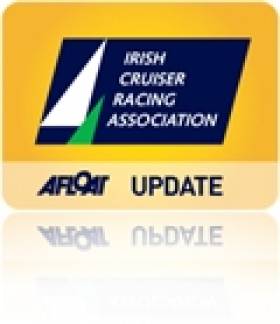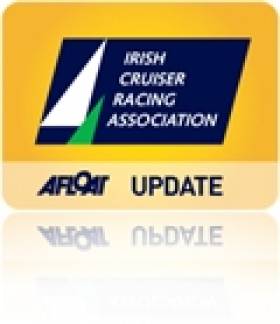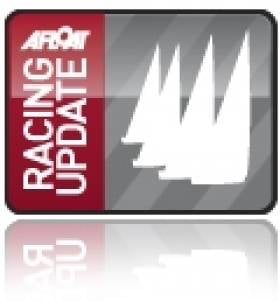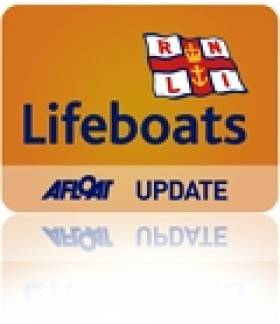Displaying items by tag: Pwllheli
Man Overboard Costs Cri Cri Shot at Welsh IRC Title
#welshIRC – Did you know there was a catchy named 'RORC North Western IRC Regional Championships' submerged beneath 'Abersoch Keelboat Week'? As one Irish interloper explained it's been some years since a week swinging on a mooring was de rigueur and Keelboat Week attracted much beyond local interest. Down the road at Pwllheli they have a well serviced marina, a national events centre with grand plans for expansion and a Celtic Regatta that has also recently become of little more than local interest.
Put the cruiser/racer event and the cruiser/racer friendly venue together and north Wales finally has the beginnings of a big boat event worth travelling for. For 2014 the rebadged Spinlock Welsh IRC Championships, with the support of ISORA and ICRA, drew interest from the north west of England, Scotland and Dublin and a competitive 40 boat fleet.
If competing interests can be navigated and a stable date found in the Celtic sailing calendar, add a patch of water whose simple (although not quite as minimal as the locals would like you to believe) tide and wind patterns offer a different challenge to anything found in the major sailing centres of Ireland or west of Scotland and the south coast of the Llyn peninsular may have the ingredients for a top class championships.
Confounding the measly forecast 2 races where sailed in 18 – 22 knots on the Friday. Royal Irish quarter tonner Cri Cri, skippered by Paul Colton, made a commanding start with a first in both races in Class 1, while the Sigma 33 Legless Again took 2nd and 3rd to take 2nd spot at the end of day 1. In Class 0, it was evident that Corby 36 Stratisfear, Corby 33 Imposter and Roxstar were serious contenders for the top spot with the Stratisfear taking a 2nd and 1st, Imposter taking 1st and 3rd and Roxstar 3rd and 2nd.
Overnight the fleet made welcome use of the brand new visitor and events pontoons at Pwllheli. These pontoons are part of the £8.3m investment from the European Regional Development Fund through the Welsh Government and Gwynedd Council in the new Welsh National Sailing Academy and Events Centre that will open its doors in 2015. 2 cranes are to be added by the time next years event gets under way making attending the event even easier.
After a further 4 races on Saturday Stratisfear's consistent performance put them firmly in the lead adding a 3rd and another first to two wins from the morning. Roxstar followed close on their heels.
In class 1 Molissa and She Too all ended the day in contention. Eazi Tiger's consistent performance had them in 3rd place overall, a broken life line in race 3 slipped CriCri, into 2nd place and, after some highly consistent sailing, the J97 Injenious moored for the day in first place overall.
With winds over 30 knots on Sunday racing for class 1 was abandoned. In class 0 local J109s Mojito and Sgrech got the best starts on the 24nm course and were off across the bay towards the St. Tudwal islands before some others had started as some were struggling to get sails up in the conditions.
Round the islands and through some challenging seas, Imposter took the lead and line honours with Mojito 2nd and Gringo (National Yacht Club skippered by Tony Fox) third on the water.
Irish Sailors Make Their Mark At Welsh IRC Championships
#icra – Support provided by Irish racers from ISORA and ICRA contributed to the success of last week's inaugural Welsh IRC championships. Forecasts for Pwllheli on the weekend of the inaugural Spinlock IRC Championships were predicting very light winds and many of the competitors wondered whether the full complement of races would be achieved. When the competitors emerged from the skippers' briefing they were greeted by winds of around 18 - 22 knots indicating that some good racing was on the cards for the Friday afternoon.
The Royal Dee Yacht Club Race Committee, lead by Mike Butterfield, ran two races on the first day with Cri Cri, Royal Irish Yacht Club skippered by Paul Colton, making a commanding start with a first in both races in Class 1, while Legless Again took 2nd and 3rd to take 2nd spot at the end of day 1. In Class 0, it was evident that Stratisfear, Imposter and Roxstar were serious contenders for the top spot with Stratisfear taking a 2nd and 1st, Imposter taking 1st and 3rd and Roxstar 3rd and 2nd.
Overnight the fleets were moored for the first time on the new visitor and events pontoons at Pwllheli. These pontoons are part of the £8.3m investment from the European Regional Development Fund through the Welsh Government and Gwynedd Council in the new Welsh National Sailing Academy and Events Centre that will open its doors in 2015. Friday night provided some legendary hospitality from Pwllheli with the Crews' dinner and a few beers.
Saturday started very wet and the wind again defied the forecasters by providing speeds in the high teens. The rain cleared in time for racing and, as it looked like it was going to be another good day on the water, the race committee capitalised by running four races. At the end of day two Stratisfear's consistent performance put them firmly in the lead adding a 3rd and another first to their morning results with Roxstar close on their heels.
In class 1, it was still all to play for with Molissa, Injenious, CriCri, and She Too in contention. However, Eazi Tiger's consistent performance had them in 3rd place overall with CriCri, who couldn't maintain Friday's excellent performance, slipping into 2nd place overall. After some consistent racing Injenious moored for the day in first place overall.
Sunday presented the fleets with higher winds for their coastal race with speeds of 27 knots being experienced in the shelter of the marina. Once out on the water, winds in excess of 30 knots were recorded and with wind over tide, boats were met by choppy seas in the bay. Many boats decided that the conditions were too much for them and didn't turn up to the start, including Roxstar and Stratisfear who realised that they had enough results to discard the last race and still win overall.
The race committee, having to endure those conditions themselves, decided that the smaller fleet, those boats with IRC handicaps less than 1.000, would not race and class 1 racing was abandoned. Local J109s Mojito and Sgrech got the best starts on the 24nm course and were off across the bay towards the St. Tudwal islands before some others had started as some were struggling to get sails up in the conditions.
Round the islands and through some challenging seas, Imposter took the lead and line honours with Mojito 2nd and Gringo (National Yacht Club skippered by Tony Fox) 3rd, but after handicaps were applied Mojito took first place, Imposter 2nd and Gringo took 3rd.
Guy Cowper, the skipper of winning boat Stratisfear, was delighted with the excellent sailing that was had by all at the Spinlock IRC Welsh Championships. He said: "This is the best bay I've ever sailed in; there's no tide, no commercial traffic and the scenery is second to none. Add to that the positive attitude of the Club's staff and volunteers and it would be difficult to have anything but a great event here. When the new Welsh National Sailing Academy building is opened next year this will be a World Class venue. I cannot wait to return to sail in Pwllheli."
The overall champion for both the Irish Crusing Racing Association (ICRA) and the Welsh Championship will be announced shortly.
The events team at Plas Heli and Pwllheli Sailing Club are currently consulting competitors regarding the format and timing of the 2015 championships which will be hosted in the new Academy facilities.
PSC Commodore Stephen Tudor said: "The Club was very proud to be offered the opportunity to host the first Welsh Spinlock IRC Championships and we are delighted that so many competitors from Ireland, Isle of Man, Scotland and Liverpool enjoyed their time in Pwllheli both on the water and ashore. The association ISORA and ICRA has strengthened the already established cross-channel link and hopefully this will continue to flourish and grow."
Overall standings for the weekend were as follows:
Class 1:
1st Injenious SCYC Hallworth Crompton
2nd CriCri Royal Irish Yatch Club Paul Colton
3rd Eazi Tiger Liverpool YC Connolly Kyffin Oliver
Class 0:
1st Stratisfear RDYC Guy Cowper
2nd Impostor SCYC Richard Fildes
3rd Roxstar Clyde Cruising Club Findlay and Anderson
Full results can be found here
#CelticRegatta - The inaugural Spinlock IRC Welsh Championships hosted by Pwllheli Sailing Club (PSC) is less than a fortnight away, with the Irish expected to make a strong showing in a competitive fleet over the weekend of 1-3 August.
And with a few free berths available in the harbour's new pontoons, there's still a chance to get involved in what's shaping up to be a strong weekend of racing.
Last year's successful J Cup at PSC was a springboard to launch the first 'Celtic Regatta', with the added award of the Spinlock IRC regional title.
The event will also showcase the recently completed visitor and event pontoons which form part of the £8.3m investment in the Welsh National Sailing Academy and Event Centre.
The Welsh Championships will be the first major event to make use of the new facilities, a year in advance of the Fireball Worlds scheduled for 17-28 August 2015.
Among the Celtic Regatta's supporters is the Irish Cruising Racing Association (ICRA), which has just completed its own successful championships hosted by the Royal Irish Yacht Club in Dun Laoghaire.
ICRA chairman and event organiser Norbert Reilly commented that the two events strengthen the ties already established across the Irish Sea. Indeed, a trophy will be awarded to the competitor with the best combined results in the two events.
And that's not to mention the Dun Laoghaire to Pwllheli ISORA Race on 26 July, a feeder race to the Welsh Championships that counts as the seventh race in the ISORA 2014 series sponsored by Kona.
"The ISORA fleet regularly visits Pwllheli either for a race start or finish and the Welsh welcome is always warm and friendly," said ISORA chairman Peter Ryan. "The new facilities in Pwllheli will make the sailing waters easily accessible and a great destination for visiting offshore fleets, flotillas and for keel boat regattas and championships."
Among the other competitors readying for the regatta is Richard Fildes, a seasoned campaigner in Cork Week and Dun Laoghaire, notably successful in his recently sold Corby 37 Impetuous.
His home waters are in Cardigan Bay, and he says he's looking forward to competing in the Welsh IRCs in his recently acquired Corby 33 Impostor - as well as return the favour of the many great Irish welcomes he's received over the years.
Fildes and the rest will race a programme designed by international race officer Mike Butterfield, who heads the IRC Welsh Championships race management team and promised to provide the best possible competition on the water.
"The bay offers ideal race management opportunities with no commercial shipping to worry about and the tidal influence is not significant," said Butterfield.
Meanwhile, PSC Commodore Stephen Tudor - a former Irish Sea ISORA Champion himself - expressed his pride in his clubs hosting of the first Welsh IRC Championships and said he is "delighted to see competitors already entered from Ireland, Isle of Man, Scotland and Liverpool in addition to the local competitive fleet.
"Entries are still being received and we still have free berths available for the event on the new academy pontoons."
Xpletive Wins ISORA's Pwllheli Day Race
An 11 mile beat to Gwylan Islands was a challenging part of ISORA's race three – the Pwllheli Day Race – and the crew on the J109 Sgrech made the best of the upwind leg getting to the Islands well ahead of the rest of the fleet.
The race was a fantastic advert for offshore racing with something for everyone and a little of everything.The forecast was for a 4 to 5 NW with WNW later and the scenic, triangular 40 mile course was set with a start from the CHPSC bridge and a short close reach to PSC 2. We then had a long (11miles) white sail reach to the Causeway cardinal buoy. The fleet at this point was bunched together with Xpletive slightly ahead but Mojito and Wennol III looking good.
The 11 mile beat to Gwylan Islands was challenging and the crew on Sgrech making the best of the upwind leg getting to the Islands well ahead of the fleet.
Then the start of the downwind spinnaker leg with what was billed as an exciting 15 miles of fast and furious not going to plan. A squall came through at Cilan Headland and caught Sgrech with her spinnaker up on the outside track. This squall brought a new head wind and allowed white sailed Xpletive to take an inside track to take the lead.
Early problems with Mojito's spinnaker allowed Wennol III through to third place at Cilan. Wennol III spotted the squall and wisely doused her spinnaker early and closed up on the leaders.
The wind backed and allowed a close reach for the finish with Expletive taking line honours closely followed by Sgrech with her a-sail closing the gap.
New to ISORA, Nanuaq, a Moody 38s thoroughly enjoyed the racing and they are now looking forward to the Pwllheli to Wicklow race on Saturday 28th May (and the party in Wicklow after racing).
| Rank | Fleet | Boat | SailNo | Type | Rating | Start | Finish | Elapsed | Corrected | Points |
|---|---|---|---|---|---|---|---|---|---|---|
| 1 | Class 1 | Xpletive | 4242 | X Yachts | 1.027 | 10.35.00 | 16.25.55 | 5.50.55 | 6.00.23 | 92.7 |
| 2 | Class 2 | Sgrech | GBR9319R | J109 | 1.026 | 10.35.00 | 16.27.03 | 5.52.03 | 6.01.12 | 82.1 |
| 3 | Class 2 | Wennol | GBR 1347 | 1.008 | 10.35.00 | 16.46.00 | 6.11.00 | 6.13.58 | 71.4 | |
| 4 | Class 3 | Mojito | GBR4184 | Bravaria 38 | 0.998 | 10.35.00 | 16.57.24 | 6.22.24 | 6.21.38 | 60.7 |
| 5 | Class 3 | Nanuq | 6395 | 0.965 | 10.35.00 | 17.55.00 | 7.20.00 | 7.04.36 | 50.1 |
Eleven Races in Busy Irish Sea Offshore Schedule
Chairman of ISORA Peter Ryan sets out the 2011 programme for ISORA that kicks off on April 7th with an introductory evening on April 7th.
Spring has come and the days are getting longer. It is now time to be thinking about offshore racing again. The first race is on the 30th April from Dun Laoghaire to Holyhead.
I attach again the latest Race Schedule, Notice of Race, Conditions and Entry Form for 2011. I also attach details of the proposed "Offshore Introduction" night for offshore racing on the 7th April. Even if you are experienced, you can add to the proceedings or just come for the reception after.
There is an extensive list of eleven races in the schedule. The types of race vary greatly to give a variety of racing experiences. There are Day Races, Night Races, Short Cross Channel Races, Medium Cross Channel Races, 100 mile Lyver Trophy Race and "The Dingle Skellig Hotel D2D" – Dingle Race. There is racing for IRC, IRC No Spinnaker and 2-handed classes.
This season, if the number of entries permits, we will be running a Classic Class in both Class 1 & 2. The boats eligible for the Classic Classes will be selected by the Sailing Committee before the start of the first race and the selection will be based on the boats performance / capability during the previous season. It is hoped that this will provide a much greater spread of prizes. The rating break for Class 1 and Class 2 will be decided at the same time.
The Race schedule has been carefully selected to ensure the maximum amount of sailing and social life is obtained. The usual "get together" will take place before and after each race. This season we have some additional attractions:
If desired, the race on the 28th May from Pwllheli to Wicklow can be followed by boats taking part in the "Turbine Race" (see www.arklowsc.com on Sunday 29th. This race starts and finishes in Arklow, 10 miles from Wicklow. This will allow the usual "get together" in Wicklow on Saturday evening and another one in Arklow on Sunday after the Turbine Race. This is the UK Bank Holiday weekend and will allow the UK boats time to return home on Monday!
After taking part in the "Dingle Skellig Hotel D2D Dingle Race" on the 11th June. Please note that a second separate entry to the NYC is required if taking part in this race in the series. After a few relaxing nights in Dingle, you can wander around to take part in the "ICRA Championships" in Crosshaven before making your way to Kinsale for the "Sovereign's Cup". The Dingle Race is a qulaifier race for the Fastnet Race.
The Lyver Race on the 1st July is a Feeder Race to the Volvo Dun Laoghaire Regatta from the 7th-10th July – a great few days sailing in Dublin Bay. This race is a RORC qualifier for the Fastnet Race. Again, seperate entry is required for the Liverpool Yacht Club sections of the event.
The Sunday Race on the 14th August will take place directly after the start of the Solitaire du Figaro fleet from Dun Laoghaire. If possible we will set a course to follow the fleet down the coast. For visiting boats to Dun Laoghaire, the Figaro fleet will arrive in Dun Laoghaire on the Wednesday 10th August and there will be a festival in Dun Laoghaire for the couple of days to celebrate the event. There will be great craic in Dun Laoghaire for those days.
You may not have noticed but the ISORA website www.isora.org has been upgraded and will become very active this year. There is a "Crew Register" and a "Buy and Sell" section in the "Forum" page. I would encourage everyone to register for this facility and use it to get crew for races or for crew to get boats. Try the website out.
The "ISORA Introductory Evening" in the NYC on the 7th April. The purpose of this is to encourage those boats who are thinking of taking part in Offshore Racing by a series of talks about what is involved in this type of racing. I will also use this session to demonstrate the use of the new website's "Crew Register". I also hope to issue detailed instructions by email on the use of this facility. The session will be followed by a reception where people can solialise and relax. "Prof" O'Connell and Mick Liddy will be talking at the event. I will also be encouraging participation from the audience. It will be a great night so please come and bring a friend.
I look forward to receiving your entries very soon. I would appreciate it if you could also spread the good news about ISORA and Offshore Racing.
Pwllheli RNLI Lifeboat Assists Yacht Bound for Cork
Pwllheli's RNLI all weather lifeboat was launched on Monday evening to assist a yacht which was drifting towards the shore.
The 37ft vessel with two people on board suffered engine failure around a mile south of the town and an attempt was made to lay the anchor but the rope entangled in the propellor.The lifeboat was launched soon after 10pm after flares were sighted being fired from the yacht.
A strong south westerly wind was pushing the yacht towards Gimblet Rock and it was around half a mile from the rock when located by the all weather lifeboat. The vessel, which was on passage from Pwllheli to Cork, was towed to the marina by the RNLI lifeboat.
Report on Race 4 – Pwllheli – Causeway - Bardsey – India Nt - Wicklow – 5th June 2010.
From an entry list of 28 sailing boats, 14 boats came to the line in Pwllheli for the 4th ISORA race – 75 miles to Wicklow. Due to tidal difficulties the race start time was brought forward to 07.15. The weather forecast was for light winds increasing to Force 3 or 4 and veering North West. However a reasonable wind of 8kts in Pwllheli, early in the morning convinced the Race Organiser to hold the planned course to Wicklow. The wind held well for the beat to Causeway and for the tight spinnaker reach towards Bardsey. “ Galileo” was first around Causeway followed by “Tsunami”.
As the fleet approached Bardsey the wind dropped to virtually nothing. “Tsunami” had just enough wind to creep around Bardsey first while the remainder of the fleet wrestled with the possibility of the tide pushing them through the sound and around the wrong side of Bardsey.The wind picked up from the West for “Tsunami” after the rounding Bardsey and a fast passage to Wicklow was expected. This was not to be as the wind died again and a heavy sea mist appeared. There was little or no wind for 3-4 hours. When eventually the mist lifted and the westerly wind appeared again, only four boats were visible – “Tsunami”, “Raging Bull”, “Just Enough” and “Lula Belle”.
The four boats continued across the Irish Sea, within sight of each other, with the wind shifting all the time and disappearing at times. At approximately 02.30 on Sunday morning “Raging Bull” rounded Nt India followed by “Tsunami” and “Just Enough”. “Lula Belle” could not be seen. The wind picked up again and soon there was 14kts of wind from the North West and the boats roared towards the Wicklow finish.
The wind had not finished playing its tricks. The usual “Wicklow Hole” had formed within one mile of the finish line and the boats ground to a halt as they arrived there. Very tricky sailing was required to manoeuvre in the light winds and the then strong south going tide to the finish.The first boat to cross the finish line was “Raging Bull” at 04:01, who only managed to take 2nd Overall and 1st in Class 1. It was followed closely by “Tsunami” who took 2nd in Class 1 and 3rd Overall. “Just Enough” appeared over the finish line at 04:28 to take the Overall Win and Class 2. “Lula Belle” continued to battle the fluky conditions and finished at 12:25 to take 4th Overall and 2nd Class 2.
There were no other finishers.
The next race is next weekend 13th June, a Sunday Day Race from Dun Laoghaire. It is hoped that some new boats will use this race as a “taster” for ISORA. An Après Sail get together is arranged in the NYC after the race.
Results and Entry form race five is attached.
ISORA Get Ready to Race from Pwllheli to Wicklow
Just three weeks before the Round Ireland sailing race kicks off in Wicklow ISORA is preparing to race there in June 5th's race from Pwllheli in North Wales. When most regattas and events this season have struggled to raise entries the ISORA season has been marked with a dramatic rise, taking the offshore fleet to over 20 boats. Entry list and more details for he fourth race (inlcuding eve of race BBQ steaks in Wales) are on the ISORA thread on the Afloat forum here.


























